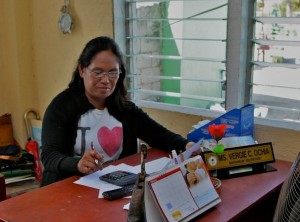Philippines typhoon, one month later: After the nightmare, a new day
 Oxfam staffers distribute water kits in Mancilang, a district of the Philippines where many residents lost their homes in the typhoon. The kits include jugs to carry water and a treatment solution to disinfect it. Photo: Jire Carreon/Oxfam
Oxfam staffers distribute water kits in Mancilang, a district of the Philippines where many residents lost their homes in the typhoon. The kits include jugs to carry water and a treatment solution to disinfect it. Photo: Jire Carreon/Oxfam
“My unforgettable experience. My nightmare.”
That’s how Vergie C. Ochia describes the day Typhoon Haiyan—also known as Yolanda—struck her home on the Filipino island of Bantayan. One month ago, on November 8, Ochia and her neighbors were crowded into their town’s community hall for shelter, listening fearfully to the rain and wind howling outside. “Everyone was crying. Everyone was praying,” she told Oxfam’s Jane Beesley. “No one was expecting to live.”

Ochia and those sheltering with her survived physically unharmed. But the 50-year-old single mother of two adopted sons suffered a loss of another kind.
“Very early the next day, 5 a.m., I went back to my house. It was gone,” she said. “I don’t know when I can start to rebuild … [The typhoon] destroyed so many homes.”
Ochia, who serves as secretary of her barangay, or district, of Mancilang, played a leadership role during the storm: she and other community officials helped make sure local families were safely sheltered and fed. Today, despite the loss of her home, Ochia continues to play that role, working with Oxfam to ensure that aid reaches those who need it most.
“I’m here at the barangay hall helping Oxfam to organize their distribution of hygiene and water kits,” she explained. The hygiene kits contain soap, toothpaste, underwear, sleeping mats, mosquito nets, and other essential supplies. Water kits include both a jug to carry water and a treatment solution to disinfect it and make it safe for drinking.
“I’ve also received a hygiene kit. I cried when I opened the bag,” said Ochia. “There were so many items. So many things we all need.”
Oxfam has distributed hygiene kits to nearly 10,000 people on Bantayan Island–part of a relief effort that has now reached nearly 250,000 people across the Philippines. While these emergency supplies are helping to tide over families who lost everything, communities will also need long-term to support to help them recover and build back stronger. On Bantayan Island, Oxfam will be working to support fisherfolk, farmers, and small businesspeople so they can earn a living and rebuild their homes and businesses. Local leaders like Ochia will be crucial to these efforts.
Despite the progress Filipinos and aid groups have made in the past month, a great deal of work remains to be done, especially in hard-to-reach areas. Oxfam’s goal is to help 500,000 people.
“Our main concern now is reaching rural communities who have not received anything like adequate assistance yet and making sure communities are able to quickly rebuild their homes, infrastructure, and livelihoods in a way that will make them more resilient to future shocks,” said Justin Morgan, the director of Oxfam’s programs in the Philippines.
Support families working to rebuild. Help Oxfam scale up our response in the Philippines: Donate to the Typhoon Haiyan Relief and Recovery Fund.